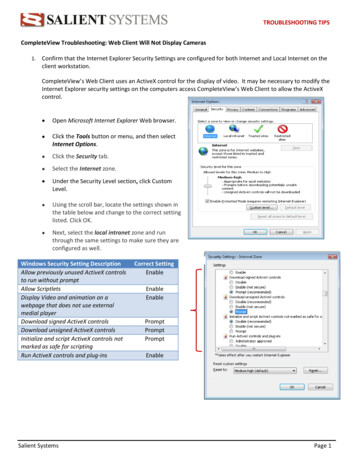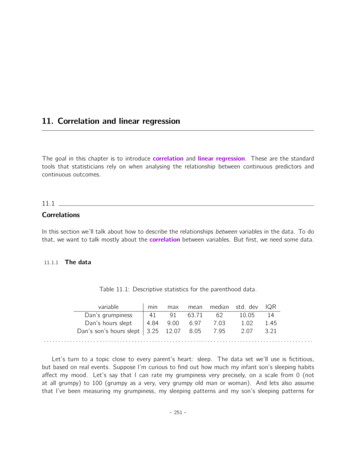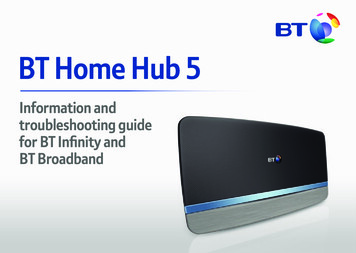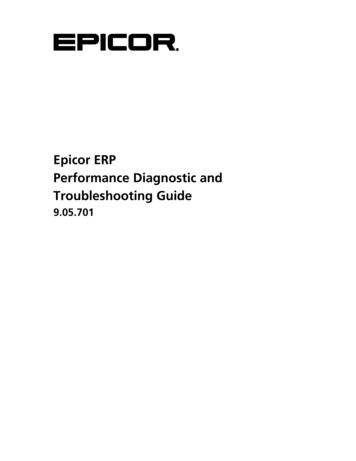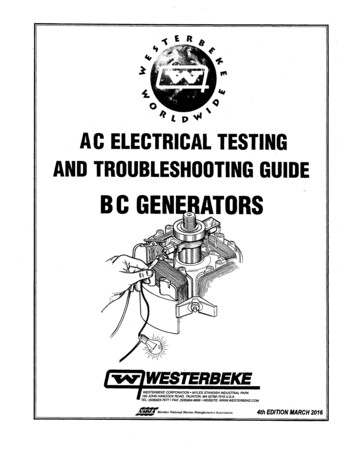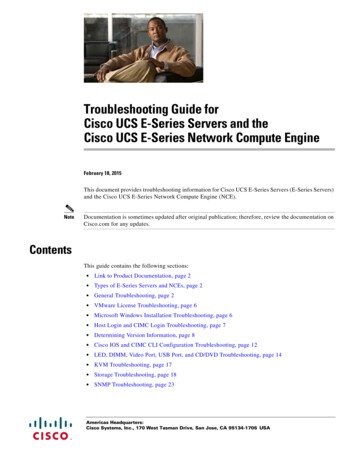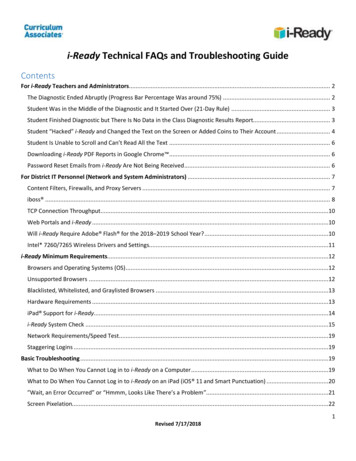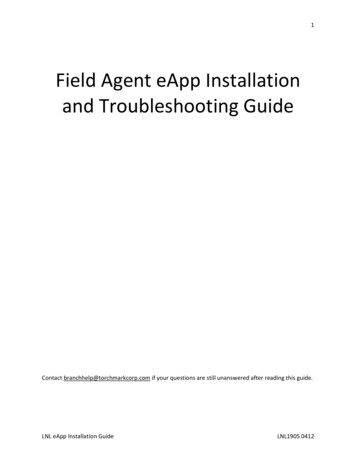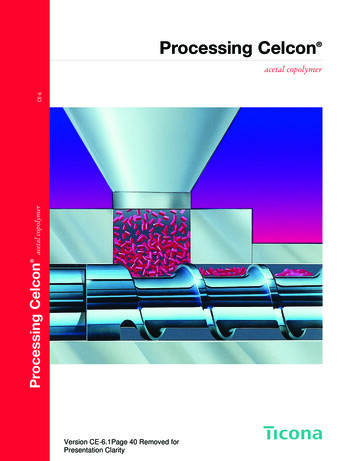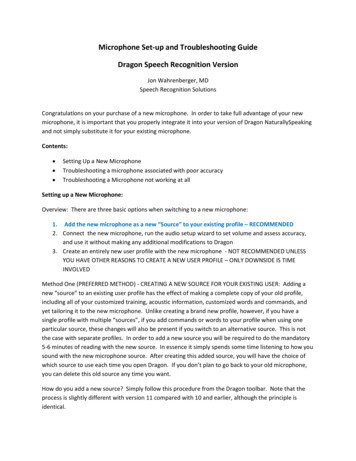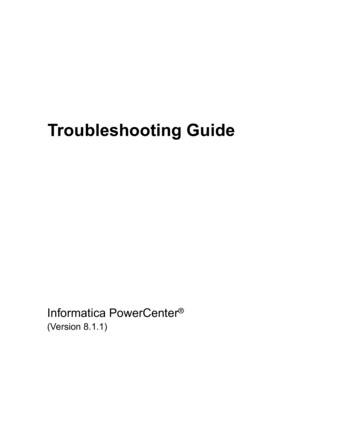
Transcription
Troubleshooting and Maintenance Guide
The only warranties for Hewlett-Packard products and services are set forth in the expressstatements accompanying such products and services. Nothing herein should be construed asconstituting an additional warranty. HP shall not be liable for technical or editorial errors oromissions contained herein.HP assumes no responsibility for the use or reliability of its software on equipment that is notfurnished by HP.This document contains proprietary information that is protected by copyright. No part of thisdocument may be photocopied, reproduced, or translated to another language without the priorwritten consent of HP.Hewlett-Packard CompanyP.O. Box 4010Cupertino, CA 95015-4010USACopyright 2005–2007 Hewlett-Packard Development Company, L.P.May be licensed in the United States by one or both of U.S. Patents Nos. 4,930,158 and4,930,160 until August 28, 2008.Microsoft and Windows are U.S. registered trademarks of Microsoft Corporation.The Windows logo is a trademark or registered trademark of Microsoft Corporation in the UnitedStates and/or other countries/regions.HP supports lawful use of technology and does not endorse or encourage the use of our productsfor purposes other than those permitted by copyright law.The information in this document is subject to change without notice.
Table of ContentsMaintenance.1Creating Data Backup Discs . 1Creating System Recovery Discs . 1Removing Unused Programs. 1Running the Disk Cleanup Program. 2Running Disk Cleanup manually . 2Scheduling Disk Cleanup to run automatically . 2Running the Disk Defragmenter Program. 3Checking for Hard Disk Drive Errors . 4Understanding Hard Disk Drive Space . 4Recommended Maintenance Schedule . 5Troubleshooting Computer Problems .7Audio . 8CD and DVD Drives . 9Video.11Display (Monitor).11Hard Disk Drive. 12Hardware Installation.12Internet Access .14Keyboard and Mouse .16Power . 17Performance .18Miscellaneous .20Repairing Software Problems .21Software Repair Overview.21Restarting Your Computer . 22Turning Off Your Computer.22Updating Drivers .22Microsoft System Restore . 23Software Program and Hardware Driver Reinstallation .24Table of Contentsiii
System Recovery .25Creating Recovery Discs.25Choosing Recovery Disc Media. 26System Recovery Options . 26Running System Recovery from the Hard Disk Drive .26Starting System Recovery from the Windows Vista Start menu . 27Starting System Recovery from system startup . 27ivTroubleshooting and Maintenance Guide
MaintenanceThis section includes information about tasks you can perform to help ensure the troublefree operation of your computer, and to ease the recovery of important information onyour computer should problems arise in the future.Creating Data Backup DiscsYou can use the CD or DVD burning software included on your computer to create backupdiscs of important information including personal files, e-mail messages, and Web sitebookmarks.When writing data to a backup disc, you should use software that includes writeverification functionality. This verification feature compares the data on your hard diskdrive with the data copied to the disc to ensure it is an exact copy. Depending on your discburning software, you may need to manually enable this feature.Creating System Recovery DiscsThis is a one-time step that you should perform while your computer is working properly. Ifyou later encounter problems with your computer, you can restore it to its original factorysettings using the System Recovery discs that you create.Before creating recovery discs, read “System Recovery” on page 25, and then create thediscs as described in “Creating Recovery Discs” on page 25.Removing Unused Programs1 Click the Windows Start Button , and then click Control Panel.2 Click Uninstall a program. The Programs and Features window opens.3 Select the program you want to remove, and click Uninstall.4 Follow the onscreen instructions.NOTE: Some programs have their own uninstall features. If you cannot uninstall aprogram from the Control Panel, refer to the program documentation or Help.Maintenance1
Running the Disk Cleanup ProgramThe Disk Cleanup program frees up space on your hard disk drive by removing temporaryand unused files (including Temporary Internet Files and files in the Recycle Bin). You canrun Disk Cleanup manually, or you can set it up to run automatically.Running Disk Cleanup manually1 Click the Windows Start Button, All Programs, Accessories, System Tools,and then click Disk Cleanup.Disk Cleanup searches for files to delete and calculates how much disk space can besaved.2 Choose the files to delete by placing a check mark in the check box next to the filetypes listed.3 Click OK, and then click Delete Files to finish deleting the selected files.Scheduling Disk Cleanup to run automatically1 Click the Windows Start Button, All Programs, Accessories, System Tools,and then click Task Scheduler.2 Click Action, and then click Create Basic Task.3 Type a name for the task and an optional description, and then click Next.4 Select the reoccurrence, and click Next.5 Select the time to run Disk Cleanup and click Next. Disk Cleanup may take a longtime, so select a time when the computer is on but not in use.6 Select Start a program and click Next.7 Under Program/Script, click Browse.8 Type cleanmgr.exe and click Open.9 Review the summary of the schedule you have set. When done, click Finish.Disk Cleanup runs at the time you have set.2Troubleshooting and Maintenance Guide
Running the Disk Defragmenter ProgramWhen Microsoft Windows Vista stores files on your hard disk drive, it often dividesthem into multiple pieces (or fragments) so they fit into available space on the drive. Whenyou attempt to open a fragmented file, it must be retrieved from more than one place, sothe process takes more time.The Disk Defragmenter program groups the fragmented files together on your hard diskdrive to improve computer performance. This does not affect the location of files andfolders on your computer.NOTE: The Disk Defragmenter program may take a long time to complete. You can run itunattended overnight.1 Save your work and close all open programs.2 Press the Ctrl key, the Alt key, and the Delete key at the same time.3 Click Start Task Manager.4 On the Applications tab, select all the programs that are listed, and then clickEnd Task. Close the Task Manager.5 Click the Windows Start Button, choose All Programs, Accessories, SystemTools, and then click Disk Defragmenter.6 Click Defragment Now.If Disk Defragmenter repeatedly starts, a hidden background program is still accessing thehard disk drive. Restart the computer and run the Disk Defragmenter program again:1 Click the Windows Start Button, click the arrow next to theLock button, and then click Restart.2 After Windows Vista starts, use the previous procedure to run theDisk Defragmenter program.Maintenance3
Checking for Hard Disk Drive ErrorsPerform the following procedure to check the integrity of the hard disk drive in WindowsVista. Close all open programs before beginning the disk check.1 Click the Windows Start Button, and then click Computer.2 In the window that opens, right-click the hard disk drive that you want to check, andclick Properties.3 In the Properties window, click the Tools tab.4 Under Error-checking, click Check Now.5 If desired, click the check box next to Automatically fix file system errors andScan for and attempt recovery of bad sectors.6 Click Start. If prompted to restart, click Yes to restart the computer.Understanding Hard Disk Drive SpaceHewlett-Packard and Compaq computers with the Windows Vista operating systempreinstalled may appear to have a hard disk drive smaller than what is stated in theproduct specifications, in the documentation, or on the box. Hard disk drives aredescribed and advertised by manufacturers in terms of decimal (base 10) capacity.Windows Vista and other programs, such as FDISK, use the binary (base 2) numberingsystem.In decimal notation, one megabyte (MB) is equal to 1,000,000 bytes, and one gigabyte(GB) is equal to 1,000,000,000 bytes. In the binary numbering system, one megabyte isequal to 1,048,576 bytes, and one gigabyte is equal to 1,073,741,824 bytes. Becauseof the different measuring systems, you may see a difference between the size reported byWindows Vista and the size advertised. The storage capacity of the hard disk drive is asadvertised.Windows Vista reports smaller capacity in the Windows Explorer tool and in the Computerwindow because it shows information about one partition on the hard disk drive at a time.The first partition contains the System Recovery information.4Troubleshooting and Maintenance Guide
Recommended Maintenance ScheduleDailyWeeklyMonthlyQuarterly (seasonally)Manage e-mailProtect againstviruses, adware,and spywareUse WindowsUpdateSet new passwords Delete e-mail fromunknown sources. Do not openuntrustedattachments. Organize e-mail. Update definitionfiles or schedule aweekly automaticupdate. Run a full virus,adware, andspyware scan orschedule a weeklyautomatic scan.Optimizeperformance Run Disk Cleanup.(See “Running theDisk CleanupProgram” onpage 2.)Run DiskDefragmenter.(See “Running theDisk DefragmenterProgram” onpage 3.)Check for diskerrors.(See “Checking forHard Disk DriveErrors” on page 4.) Check for updates orschedule a monthlyautomatic update.(See the GettingStarted guide fordetails.)Review theStart menu Set to open onlyneeded applications:1 Click the WindowsStart Button, AllPrograms, thenclick WindowsDefender.2 Click Tools.3 Click SoftwareExplorer.4 In the Category list,select StartupPrograms.(See the Getting Startedguide for details.)Clean the computer,monitor, keyboard,and mouse For detailed cleaninginstructions, go to:http://www.hp.com/supportSelect your country/region and language,search on yourcomputer modelnumber, and thensearch on the keywordcleaning.5 Select the programthat you want toprevent from runningand click Disable.Maintenance5
Recommended Maintenance Schedule (continued)DailyWeeklyMonthlyClean up Webbrowser filesClean up the desktop Delete cookies. Delete cache. Delete history files.Empty theRecycle Bin 6This, and othercleanup tasks, canbe performed withthe Disk Cleanupprogram.(See “Running theDisk CleanupProgram” onpage 2.) Delete or uninstallunneeded iconsand applications.(See “RemovingUnused Programs”on page 1.)Maintain overallcondition Check cleanliness. Make sureventilation isunobstructed. Secure allconnections andcabling.Back up importantfiles to CD or DVDCreate a RestorePoint(See “Creating DataBackup Discs” onpage 1.)(See “Microsoft SystemRestore” on page 23.)Troubleshooting and Maintenance GuideQuarterly (seasonally)
Troubleshooting Computer ProblemsThis section contains a series of tables that describe possible solutions to problems thatmay occur when using your computer. Each table contains: Symptoms that describe the sign or warning message for the type of problem. Possible solutions that describe what you should do to try to solve the problem.The troubleshooting tables appear in the following order: Audio CD and DVD Drives Video Display (Monitor) Hard Disk Drive Hardware Installation Internet Access Keyboard and Mouse Power Performance MiscellaneousFor additional information about monitor problems, or for problems relating specifically toyour printer, refer to the documentation provided by the product’s manufacturer.Troubleshooting Computer Problems7
AudioASymptomPossible solutionNo sound is produced.Press the Mute button on the keyboard to see if the Mute feature is turned on.Or1 Click the Windows Start Button, and then click Control Panel.2 Click Hardware and Sound, and then Adjust system volume.3 If applications are muted, click the mute button to unmute.Click the task bar Volume icon (the volume.), or use the keyboard controls to increasePress the Sleep button (select models only), or press the Esc key on thekeyboard to resume from sleep mode.Unplug headphones if they are connected to your computer.Codec error messages appearwhen certain audio files areplayed.Open the file in Windows Media Player. Ensure Windows Media Player isconfigured to automatically download codecs. If the correct codec is available, the file will play. Note that you must beconnected to the Internet to download the codec file. If the correct codec is not available, check to see if there is an updateavailable for Windows Media Player.For more information, open Windows Media Player Help, and then search theonline Help for codec.8Troubleshooting and Maintenance Guide
CD and DVD DrivesSymptomPossible solutionThe CD or DVD drive cannotread a disc or takes too longto start.Ensure the disc is inserted with the label facing up and centered in the tray.Wait at least 30 seconds to let the drive determine the type of media.Clean the disc with a disc cleaning kit, available from most computer stores.The driver may be corrupted or outdated. Refer to “Updating Drivers” onpage 22 for detailed information about restoring and updating drivers.I cannot remove a CD or DVD. Turn on your computer, and press the Eject button nearest the drive to openthe tray.If you suspect a problem with the actual Eject button:1 Click the Windows Start Button and then Computer.2 Right-click the DVD drive.3 Select Eject from the menu.Remove the drive from the computer and use a straightened paper clip to pressthe manual release hole. For information about removing the DVD drive, referto the “Removing a Memory Module” section in the “Upgrading the HPTouchSmart PC” chapter in the User Guide.Manual release holeTroubleshooting Computer Problems9
CD and DVD Drives (continued)SymptomPossible solutionI cannot create (burn) a disc.Ensure the disc is inserted with the label facing up and centered in the tray.Verify that you are using the correct disc type (media) for the drive. Try adifferent brand of disc.Make sure the disc is clean and undamaged. If recording stopped during arecording session, the disc may be damaged; use a different disc.Use the correct type of disc for the type of files you are recording.When using a CD-R disc, make sure that it is blank when recording music andis blank or appendable (with space to add more data files) whenrecording data.Verify that you are using the correct disc type when making a copy of a disc.Some recording programs can record only to the same disc type as the source.For example, you can record a DVD only to a DVD R/-R or a DVD RW/-RWdisc, and you can record a CD only to a CD-R or a CD-RW disc.Select a slower write speed for the recording drive, if it is available.The recording software may not let you add a track if it exceeds the availablespace on your disc. You can make space available by removing one or moretracks from the list before recording the files to disc.Close all software programs and windows before recording.Make sure you have enough space available on your hard disk drive to store atemporary copy of the content.Click the Windows Start Button, then Computer. View the spaceavailable on the hard disk drive.If you are on a network, copy the files from a network drive to your hard diskdrive first, and then record them to disc.Close all programs and windows and then restart your computer.I cannot add data to a DVD.Make sure you set the correct recording option (append or add data files) inyour DVD burning software.Titles of music tracks are notdisplayed for the CD.The computer must be connected to the Internet for the artist, title, and trackinformation to appear when playing music CDs. This information is notrecorded on the disc.Track information may not be available for every CD.An error message appearswhen capturing video.You may need to select the capture device if your computer has both an analogand a digital video capture device. Refer to the Help menu in the video captureprogram to find out how to change the video device selection.I cannot play a DVD movie ona DVD player.Your DVD player cannot play video files recorded onto the DVD as data files.To play a movie properly, use a video recording program. Some video filesmay be viewed on a computer, but not on a home DVD video player.10Troubleshooting and Maintenance Guide
VideoSymptomPossible solutionSome video files do not play.Your file may be corrupt or in an unsupported format. Open the video file in avideo editor, and then resave the file in a supported format.Codec error messages appearwhen I play certain video files.Open the file in Windows Media Player. Ensure Windows Media Player isconfigured to automatically download codecs. If the correct codec is available, the file will play. Note that you must beconnected to the Internet to download the codec file. If the correct codec is not available, check to see if there is an updateavailable for Windows Media Player.For more information, open Windows Media Player Help, and then search theonline Help for codec.Error message: Files NeededTo Display Video Are Missingor Corrupt.1 Click the Windows Start Button, right-click Computer, and thenselect Properties.2 Under Tasks, click Device Manager.3 Click the plus sign ( ) next to Sound, video and game controllers.4 Right-click TV tuner (select models only) and then select Update DriverSoftware.5 Select Search automatically for updated driver software.6 Follow the instructions to update the driver.7 If prompted, restart the computer.Display (Monitor)SymptomPossible solutionScreen is blank.Press the space bar or move the mouse to make the screen display visibleagain.Press the Sleep button (select models only), or press the Esc key on thekeyboard to resume from sleep mode.Press the Display On/Off button on the keyboard.Press the On button to turn on the computer.Images on the screen are toolarge or too small, or theimages are fuzzy.Adjust the monitor resolution setting in Windows Vista:1 Right-click the desktop, and then select Personalize.2 Click Display Settings.3 Adjust the Resolution slider as needed.Troubleshooting Computer Problems11
Hard Disk DriveSymptomPossible solutionComputer seems to be lockedup and not responding.Use the Windows Task Manager to close any programs not responding orrestart the computer:1 Press the Ctrl key, the Alt key, and the Delete key on the keyboard at thesame time.2 Click Start Task Manager.3 Select the program that is not responding, and click End Task.OrIf closing programs does not work, restart the computer:Hard disk drive error messagedisplays.aPress the Ctrl key, the Alt key, and the Delete key on the keyboard atthe same time.bClick the arrow next to the Shut Down button and then clickRestart.cIf this does not work, press and hold the On button for 5 or moreseconds to turn off the computer. Then, press the On button to restart.Press the HP Help button on the keyboard to open the Help and SupportCenter, or refer to the Limited Warranty and Support Guide to contact Support.Hardware InstallationSymptomPossible solutionA new device is notrecognized as part of thesystem.Install the device driver from the CD provided with the device, or downloadand install the driver from the device manufacturer’s Web site.You may need an updated driver for Windows Vista. Contact the devicevendor directly for an update.For HP peripherals, visit the HP Web site. Refer to the Limited Warranty andSupport Guide for details.Ensure that all cables are properly and securely connected and that the pins inthe cable or connector are not bent.Turn off the computer, turn on the external device, and then turn on thecomputer to integrate the device with the computer.12Troubleshooting and Maintenance Guide
Hardware Installation (continued)SymptomPossible solutionA new device is notrecognized as part ofthe system.(continued)Restart the computer, and follow the instructions for accepting the changes.Deselect the automatic settings in the operating system for the card, andchoose a basic configuration that doesn’t cause a resource conflict.You can also reconfigure or disable devices to resolve the resource conflict.A new device does not work.You must be logged in with administrative privileges toinstall or uninstall a device driver. If you need to switchusers, click the Windows Start Button, click the Arrowbutton next to the Lock button, and then click Switch User. Choose a userwith administrative privileges.A device does not work afterinstalling a new device.To resolve a device conflict, you may need to disable one of the devices oruninstall an old device driver:1 Click the Windows Start Button, right-click Computer, and thenselect Properties.2 Under Tasks, click Device Manager.3 Click the plus sign ( ) next to the problem device and check forexclamation points in a yellow circle near the device icon. Theexclamation point means there is a device conflict or problem with thedevice. Exclamation points do not always appear when a device is notworking properly.4 If you have removed a hardware device and the device driver is listed inthe Device Manager, this may be causing the device conflict. To uninstallthe old driver for the new device driver to work properly, do the following:Right-click the device, click Uninstall, and then click OK.5 Double-click the name of the device, and select Properties.6 If available, click the Resources tab to verify that there is a deviceconflict.7 Click the General tab to see if your device is enabled and workingproperly. If it is available, click the Troubleshoot button, and follow theonscreen instructions in the device troubleshooter wizard.8 Restart the computer. Click the Windows StartButton, click the Arrow button next to the Lockbutton, and then click Restart.Troubleshooting Computer Problems13
Internet AccessSymptomPossible solutionI cannot connect to theInternet.Open the Network and Sharing Center to check for Internet connectionproblems:1 Click the Windows Start Button, and then click Control Panel.2 Click Network and Internet, then click Network and SharingCenter.Verify Internet settings, or contact your Internet Service Provider (ISP) forassistance.Verify that you are using the proper cables for your Internet connection type.Your computer has an Ethernet network adapter (also called a networkinterface card, or NIC). A NIC uses a network cable to connect to a local areanetwork (LAN). Do not connect a telephone cable to the NIC. Do not plug anetwork cable into a telephone service line; doing so may damage the NIC.For more information about connecting to the Internet, press the HP Help buttonon the keyboard to open the Help and Support Center.Verify that the Web browser is installed and set up to work with your ISP.Try to connect again later, or contact your ISP for assistance.I cannot automatically startInternet programs.Log in to your ISP, and start the desired program.Web pages load slowly.Open the Network and Sharing Center to check for Internet connectionproblems:1 Click the Windows Start Button, and then click Control Panel.2 Click Network and Internet, then click Network and SharingCenter.The AOL program opens evenwhen it is not being used.You may want to remove the AOL program.To uninstall AOL:1 Click the Windows Start Button, and then click Control Panel.2 Click Uninstall a program.3 Select America Online, click Uninstall, and then follow the onscreeninstructions.NOTE: Removing the AOL program will not cancel your account with AOL.14Troubleshooting and Maintenance Guide
Internet Access (continued)SymptomPossible solutionMy Internet browser homepage changed to somethingI did not want.You may have spyware on your computer. Spyware is software that usuallyruns silently in the background on your computer, collecting and sendinginformation about you and your use of the computer to another person orsystem on the Internet.You can find and remove spyware from your computer by using any one of anumber of software programs available for this purpose, including WindowsDefender.To scan for spyware using Windows Defender:1 Click the Windows Start Button, All Programs, then clickWindows Defender.2 Click Scan.Many of the popular virus protection programs also have some tools that scanfor and remove spyware from your computer.To avoid getting spyware on your computer:Unwanted pop-upadvertisements display on mycomputer when connected tothe Internet. Do not install programs if you are not sure they come from reputablecompanies. Check the company’s Web site carefully for information aboutwhat is included with the program. Do not automatically click Yes when a download window asks if it is OKto install a program on your computer. Read the message in the windowand make sure it is a software program that you really want.This is typically caused by adware or advertising-supported software.You can configure your Web browser to block pop-ups (available in InternetExplorer by clicking Tools and then Pop-up Blocker).To remove adware from your computer, use the antispyware/adware programincluded on your computer (select models only) or any number of availablesoftware programs that remove adware programs.Note that many of the popular antivirus programs have tools that scan for andremove adware from your computer.Troubleshooting Computer Problems15
Keyboard and MouseSymptomPossible solutionKeyboard commands andtyping are not recognized bythe computer.Restart the computer:1 Using the mouse, click the Arrow button next to theLock button, and then click Shut Down.2 Disconnect the power cord from the electrical outlet and then from thecomputer.3 Reconnect the power cord to the computer, then plug into the electricaloutlet.4 Turn on the computer.Refer to the Limited Warranty and Support Guide to contact Support.Wireless keyboard does notwork or is not detected.Wireless mouse does not workor is not detected.Cursor does not respond tomouse movement. Ensure the keyboard is within the range of the receiver. Replace the batteries in the wireless keyboard. Refer to the documentation that came with the keyboard. Ensure the mouse is within the range of the receiver. Replace the batteries in the wireless mouse. Refer to the documentation that came with the mouse.Restart your computer using the keyboard:1 Press the Alt and Tab keys on the keyboard at the same time to navigate toan open application.2 Press the Ctrl and S keys on the keyboard at the same time to save yourchanges in the selected application (Ctrl S is the keyboard command forSave on most — not all — applications).3 After saving changes in all open applications, press the Ctrl and Esc keyson the keyboard at the same time to display the Start menu.4 Use the arrow keys to select the Arrow button next tothe Lock button. Select Shut Down, and then pressthe Enter key on the keyboard.5 After the shutdown is complete, reconnect the mouse connector to the backof your computer, and then turn on your computer.Cursor responds slowly tomouse movement.16Use a mouse pad or other rough surface under the mouse.Troubleshooting and Maintenance Guide
Troubleshooting Computer Problems 7 Troubleshooting Computer Problems This section contains a series of tables that describe possible solutions to problems that may occur when using your computer. Each table contains: Symptoms that desc
